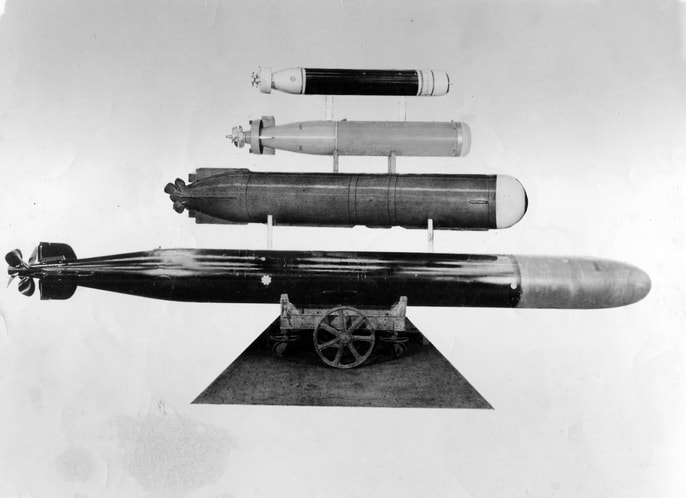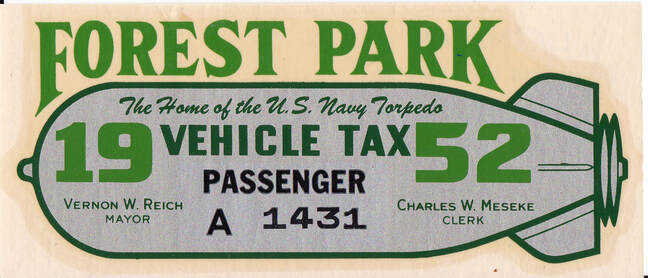Ameritorp / U.S. Naval Ordnance Station
The national emergency declared by President Franklin D. Roosevelt on September 8, 1939 established the immediate need for accelerating the production of ordnance materials for National Defense. In response, Congress passed two Acts, with the need for adequate facilities for such production. In 1940 the Secretary of the Navy selected Chicago as the location best suited for the purpose. The 80- acre, former Harlem Race Track, and Harlem Golf Course was acquired by the federal government from the Condon estate. The American Can Company was selected for the construction and management of a new Naval Ordnance Plant, and in order to effectively administer the contracts, a they formed a subsidiary, the Amertorp Corporations.
|
The first anticipated schedule called for production of 25 Mark 13 torpedoes, with plans to raise production to 290 per month for most of 1943. The Mark 13 was designed to be dropped from aircraft, was 13 feet 5 inches and was 22.5 inches in diameter, it weighed just over 2,000 lbs. and would reach speeds up to 33.5 knots (38.6 mph).
|

Mrs. Lenore Radway, left, and Miss Sherley Becker polish a torpedo flask in 1943 at the Amertorp Torpedo Ordnance Corporation in Forest Park, Illinois. As many as 6,500 workers churned out hundreds of torpedoes per month, a long-forgotten but crucial part of the war effort. — Chicago Tribune historical photo
|
February 1942 the ground broke and construction started on the U. S. Naval Ordnance Plant, in Forest Park. Two weeks later the plant’s production expectations were “significantly increased” and the plans doubled in size. The plant opened only eight months later, with a large reception on October 29, 1942.
|
The total number of people working in the plant swelled to over 6,000 personnel by late 1943 until late 1944. The Plant was awarded the Army-Navy “E” Award for outstanding production of war materials in 1944. Rear Admiral Hussey presented at the award ceremony and said “Torpedoes take a lot of manufacturing skill, know-how and expense. They are the most difficult of all Naval weapons to make, maintain, adjust and assemble…. Now you who have done so well.. we ask you to build another type. We describe it as the Mark 15.”
|
Poor combat performance of the Mark 13 (42 of 51 of the Mark 13 torpedo bombers were lost at the Battle of Midway without scoring a single hit) created the need for improvements to the torpedo.
The production schedule shifted in favor of the Mark 15, which was designed to be launched from a destroyer vessel on water, and were needed for the battles on the Pacific. They would be in peak production of 400 a month. The Mark 15 was larger, 24 feet long, with a diameter of 21 inches and weighed 3,841 lbs.
The production schedule shifted in favor of the Mark 15, which was designed to be launched from a destroyer vessel on water, and were needed for the battles on the Pacific. They would be in peak production of 400 a month. The Mark 15 was larger, 24 feet long, with a diameter of 21 inches and weighed 3,841 lbs.
On December 10, 1945, Amertorp was converted from a Contractor-operated to a Navy operated activity, the Naval Ordnance Plant. Approximately 1200 contractor employees were transferred over to the Navy and given Wartime Civil Service appointments. The mission was to manufacture new torpedoes, spare parts and tools, modernization and storage of torpedoes.
From 1945 to 1964 many changes were made to the Plant’s organizational structure, and by 1964 the production quotas of torpedoes had been drastically reduced. The mission of the plant changed to a research and engineering focus. The name of the facility was changed in 1966 to Naval Ordnance Station as a reflection of this change.
From 1945 to 1964 many changes were made to the Plant’s organizational structure, and by 1964 the production quotas of torpedoes had been drastically reduced. The mission of the plant changed to a research and engineering focus. The name of the facility was changed in 1966 to Naval Ordnance Station as a reflection of this change.

In 1970, the Defense Department decided to close the Forest Park plant. During the nearly 30 years of service to the Department of the Navy and Department of Defense, the Naval Ordnance Station, Forest Park, produced approximately 19,000 torpedoes, overhauled, converted and or modernized several thousands of torpedoes and other torpedo exploders and other items of ordnance material.
|
Forest Park selected the torpedo for it’s vehicle tag image in 1951.
|
Andrew Cernan, father of Lt. Eugene “Gene” Cernan, the Commander of Apollo 17, was the last man to walk on the moon, was a supervisor of the Naval Ordnance Plant in 1963 when his son, and Proviso High School alum, was selected to be a NASA astronaut.
|
Written by Jill Wagner











